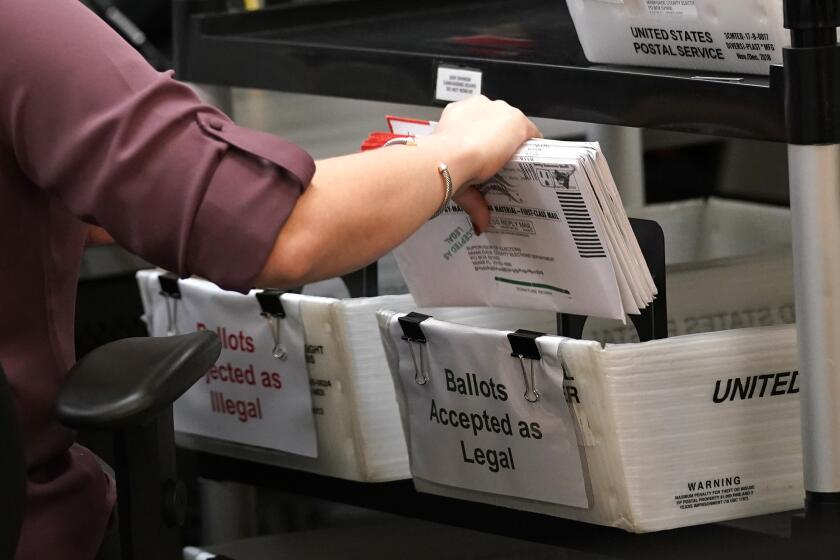‘95 Budget Pares Funds Requested by Pentagon : Spending: Plan cuts outlays for nine of 14 Cabinet departments and drops deficit to less than $200 billion.
President Clinton’s first effort to live with the austere spending limits of his five-year economic plan is a 1995 budget outlined Wednesday that cuts defense spending far below levels advocated by the Pentagon, reduces outlays for nine of 14 Cabinet departments and pushes the deficit to less than $200 billion for the first time in five years.
A government-wide spending freeze beginning next year will force the Administration to propose cuts in “literally hundreds of programs” and eliminate a wide range of programs in areas ranging from education to agriculture, Leon E. Panetta, director of the White House Office of Management and Budget, announced.
The Administration will cut 100,000 federal jobs in 1995, mostly through attrition, while freezing or slashing the budgets below current spending levels for every Cabinet department except Labor, Education, Commerce, Justice and Health and Human Services.
In intense sessions with his senior advisers Monday and Tuesday, Clinton personally made all of the critical final decisions on the shape of the budget, which largely will determine the scope and direction of the Administration’s policy for the coming year.
Clinton was working within the confines of a fiscal straitjacket that freezes discretionary spending at a level slightly more than $540 billion each year between 1995 and 1998. The freeze means that for every new dollar Clinton wants to spend on his “public investment” agenda of public works and other domestic initiatives, he must find cuts in older programs that he believes have failed to live up to their promise or have outlived their usefulness.
“This was a zero-sum game,” Panetta said. “We had to work within a cap, so wherever we wanted to (fund new programs), wherever the President felt there were important investments to be made, we had to find those resources within other budgets.”
Clinton’s final budget decisions followed weeks of internal battles between Panetta and the Cabinet secretaries, who generally fought the budget director’s orders to cut at least 10% of spending in programs not considered top priorities by the White House.
In his most controversial decision, Clinton ruled against the Pentagon on its request for an extra $30 billion in funds over the next six years to help pay for the Administration’s post-Cold War military strategy. Clinton decided not to give the Defense Department an extra $21 billion to cover the anticipated costs of inflation and told the Pentagon that it must fund roughly $9 billion in pay raises mandated by Congress by shifting money from other sections of its own budget.
The decision brings Clinton down squarely on Panetta’s side in a long-simmering feud with departing Defense Secretary Les Aspin.
The Pentagon, anticipating Clinton’s decision, already has ordered the individual military services to find a total of $13 billion in spending cuts over the next five years to help make up the shortfall, sources said Wednesday.
Overall, Panetta said, the budget cuts will help reduce the federal deficit to $190 billion in 1995, the lowest level since 1989. Last spring, the Administration had forecast that the 1995 deficit would hit $302 billion.
Clinton’s spending cuts will be offset by an 18% increase in his top priority domestic programs, providing about $16 billion for initiatives such as Head Start, crime fighting, education reform, job training and children’s nutrition, as well as new technology and defense conversion programs.
The new budget, which will be formally introduced on Feb. 7, will be the first to include cost estimates for Clinton’s health care reform plan. But Panetta pointedly said that the White House has left funding for welfare reform out of the budget, which suggests that the Administration does not expect the initiative to pass Congress next year.
Although the White House still had not told Cabinet secretaries and other agency heads about the final budget decisions, most had a good idea by Wednesday of the funding levels for leading programs.
Administration sources said, for instance, that one of the big losers in the budget battles was the Agriculture Department, long a target for the White House budget ax. The budget will include a plan to close more than 1,200 farm program field offices, first proposed in September by Vice President Al Gore’s task force on reinventing government, officials said.
In fact, many of Clinton’s spending cuts will come directly from Gore’s report. The White House will eliminate at least 33 education programs, ranging from reading instruction to bilingual vocational courses. The Administration also will sharply reduce operating subsidies for mass transit systems, but Clinton decided against completely eliminating the $800-million Transportation Department program.
In many cases, the savings from such cuts will go to other higher-priority programs in the same departments. The money saved by eliminating education programs, for example, will go for other uses determined by Education Secretary Richard W. Riley, largely to expand aid to poorer school districts.
Education, in fact, is one of the big winners in Clinton’s budget, and sources said the White House will provide $600 million to $700 million in new funds for Goals 2000, an Administration initiative to create national academic and skill standards for the nation’s elementary and secondary schools.
New funds also will be provided to the Administration’s so-called school-to-work initiative, which would provide seed money for states and localities to offer young people on-the-job training in vocational skills.
Another Labor program, to provide job training and assistance to dislocated workers, will come close to the funding level of $1.3 billion for 1995 sought by Labor Secretary Robert B. Reich, White House officials said.
Another winner will be the Justice Department. The budget includes roughly $2.5 billion in new funds for 1995 to help pay for Clinton’s crime initiatives, White House sources said. That would include putting 100,000 more police officers on the nation’s streets and providing money for new boot camps for young offenders and prison construction.
Over five years, the Administration is planning to spend about $22 billion on its anti-crime initiatives, matching the funding levels proposed in legislation now before the Senate.
Times staff writers Art Pine and Elizabeth Shogren contributed to this story.
More to Read
Get the L.A. Times Politics newsletter
Deeply reported insights into legislation, politics and policy from Sacramento, Washington and beyond. In your inbox three times per week.
You may occasionally receive promotional content from the Los Angeles Times.










